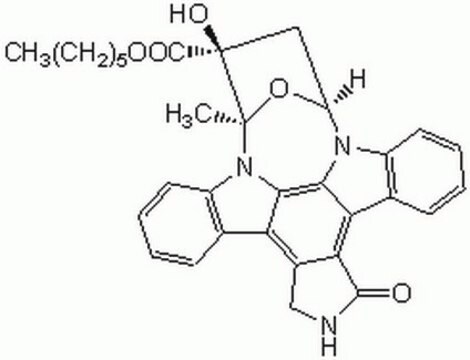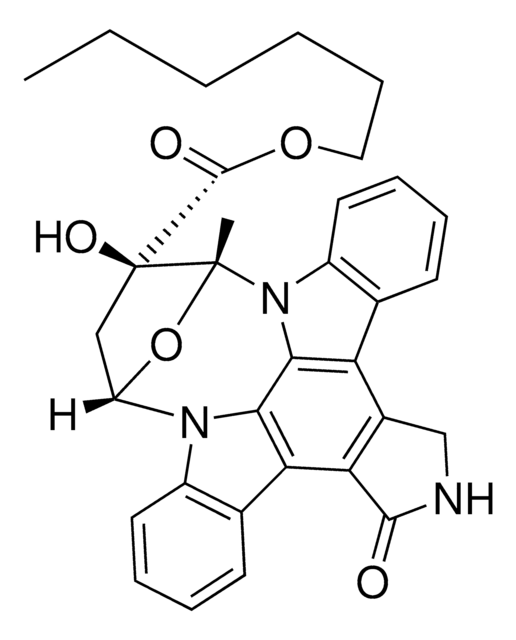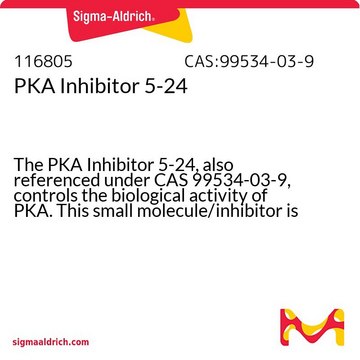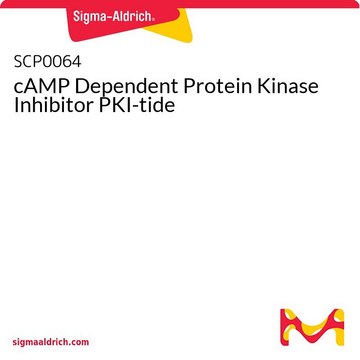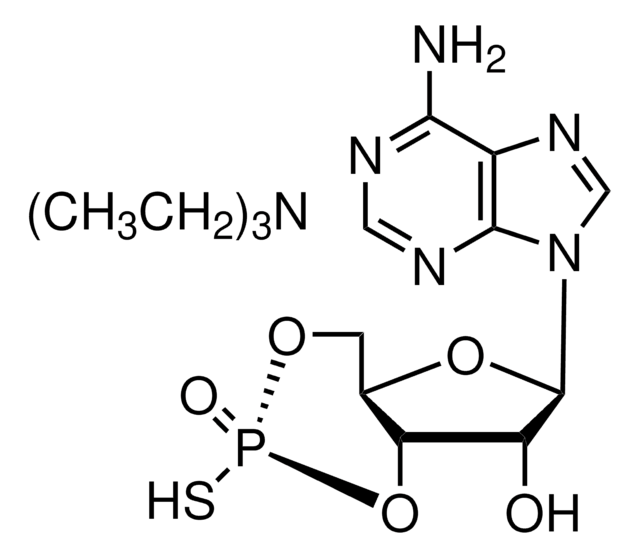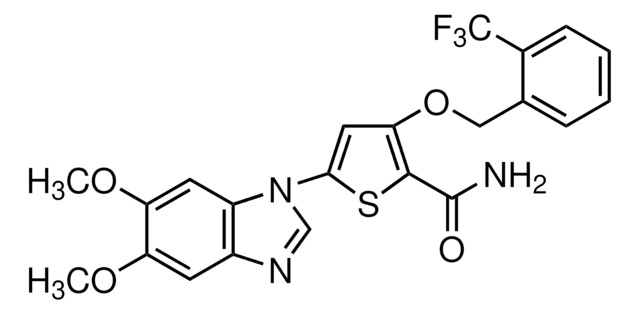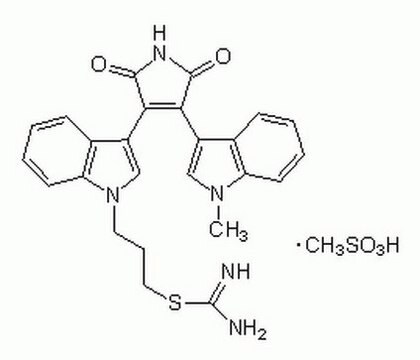371962
H-89, Dihydrochloride
InSolution 10 mM, ≥99%, reversible ATP-competitive inhibitor of protein kinase A
동의어(들):
InSolution H-89, Dihydrochloride, N-[2-(( p-Bromocinnamyl)amino)ethyl]-5-isoquinolinesulfonamide, 2HCl, PKA Inhibitor III, N-[2-((p-Bromocinnamyl)amino)ethyl]-5-isoquinolinesulfonamide, 2HCl, PKA Inhibitor III
로그인조직 및 계약 가격 보기
모든 사진(1)
About This Item
실험식(Hill 표기법):
C20H20BrN3O2S
Molecular Weight:
446.36
UNSPSC 코드:
12352200
NACRES:
NA.77
추천 제품
Quality Level
분석
≥99% (HPLC)
양식
liquid
제조업체/상표
Calbiochem®
저장 조건
OK to freeze
protect from light
배송 상태
wet ice
저장 온도
−20°C
일반 설명
A solution of H-89, Dihydrochloride (Cat. No. 371963) in anhydrous DMSO. H-89 is a cell-permeable selective and potent inhibitor of protein kinase A (Ki = 48 nM). Inhibits other kinases at several fold higher concentrations: myosin light chain kinase (Ki = 28.3 µM), Ca2+/calmodulin-dependent protein kinase II (Ki = 29.7 µM), protein kinase C (Ki = 31.7 µM), casein kinase I (Ki = 38.3 µM), and Rho Kinase II (IC50 = 270 nM). May be used to discriminate between the effects of PKA and cAMP-regulated guanine-nucleotide-exchange factors (GEFs), such as GEFI or Epac (exchange protein directly activated by cAMP) and GEFII. Reported to induce neurite formation in NG 108-15 cells (~1 µM) by blocking the action of Rho kinase II.
생화학적/생리학적 작용
Cell permeable: no
Primary Target
PKA
PKA
Product does not compete with ATP.
Reversible: no
Target Ki: 48 nM against protein kinase A
포장
Packaged under inert gas
경고
Toxicity: Irritant (B)
물리적 형태
A 10 mM (1 mg/193 µl) solution of H-89, 2HCl (Cat. No. 371963) in DMSO.
재구성
Following initial thaw, aliquot and freeze (-20°C).
기타 정보
Leemhuis, J., et al. 2002. J. Pharmacol. Exp. Ther.300, 1000.
Davies, S.P. et al. 2000. Biochem. J.351, 95.
de Rooij, J., et al. 1998. Nature.396, 474.
Kawasaki, H., et al. 1998. Science.282, 2275.
Findik, D., et al. 1995. J. Cell. Biochem.57, 12.
Hidaka, H., and Kobayashi, R. 1992. Annu. Rev. Pharmacol. Toxicol.32, 377.
Geilen, C.C., et al. 1992. FEBS Lett.309, 381.
Chijiwa, T., et al. 1990. J. Biol. Chem.265, 5267.
Combest, W.L., et al. 1988. J. Neurochem.51, 1581.
Davies, S.P. et al. 2000. Biochem. J.351, 95.
de Rooij, J., et al. 1998. Nature.396, 474.
Kawasaki, H., et al. 1998. Science.282, 2275.
Findik, D., et al. 1995. J. Cell. Biochem.57, 12.
Hidaka, H., and Kobayashi, R. 1992. Annu. Rev. Pharmacol. Toxicol.32, 377.
Geilen, C.C., et al. 1992. FEBS Lett.309, 381.
Chijiwa, T., et al. 1990. J. Biol. Chem.265, 5267.
Combest, W.L., et al. 1988. J. Neurochem.51, 1581.
법적 정보
CALBIOCHEM is a registered trademark of Merck KGaA, Darmstadt, Germany
Storage Class Code
10 - Combustible liquids
WGK
WGK 1
Flash Point (°F)
188.6 °F - closed cup - (Dimethylsulfoxide)
Flash Point (°C)
87 °C - closed cup - (Dimethylsulfoxide)
시험 성적서(COA)
제품의 로트/배치 번호를 입력하여 시험 성적서(COA)을 검색하십시오. 로트 및 배치 번호는 제품 라벨에 있는 ‘로트’ 또는 ‘배치’라는 용어 뒤에서 찾을 수 있습니다.
Nicole Welch et al.
iScience, 25(11), 105325-105325 (2022-11-09)
Skeletal muscle generation of ammonia, an endogenous cytotoxin, is increased during exercise. Perturbations in ammonia metabolism consistently occur in chronic diseases, and may blunt beneficial skeletal muscle molecular responses and protein homeostasis with exercise. Phosphorylation of skeletal muscle proteins mediates
Yanyong Xu et al.
Nature metabolism, 3(1), 59-74 (2021-01-20)
Activating transcription factor (ATF)3 is known to have an anti-inflammatory function, yet the role of hepatic ATF3 in lipoprotein metabolism or atherosclerosis remains unknown. Here we show that overexpression of human ATF3 in hepatocytes reduces the development of atherosclerosis in
자사의 과학자팀은 생명 과학, 재료 과학, 화학 합성, 크로마토그래피, 분석 및 기타 많은 영역을 포함한 모든 과학 분야에 경험이 있습니다..
고객지원팀으로 연락바랍니다.
